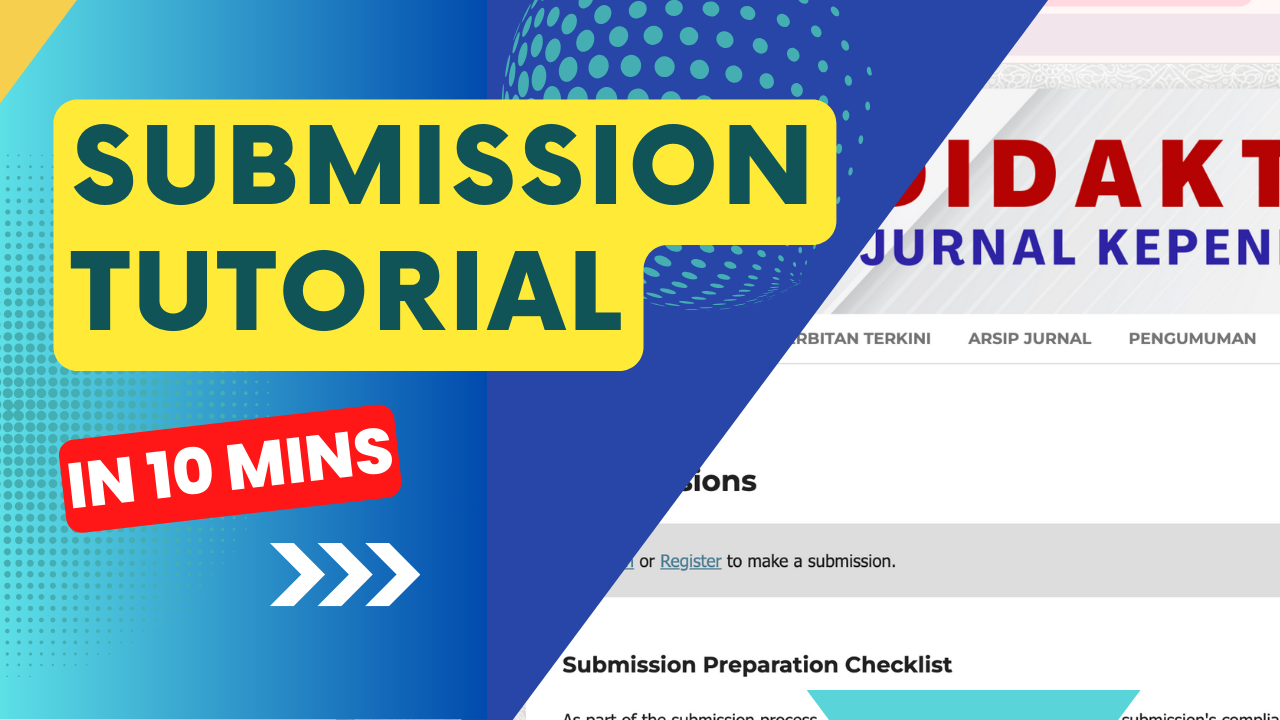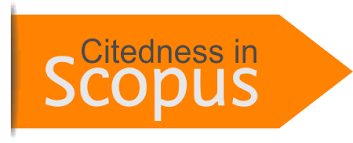The Influence of Teacher Readiness and Learning Facilities on Student Learning Motivation: Blended Learning as a Mediating Variable
Abstract
Student learning motivation after the Covid-19 pandemic has become an interesting topic, student learning motivation plays an important role in the learning process. Problems with student learning motivation can arise due to a lack of teacher readiness or lack of support for learning facilities. These factors can hinder students' interest and enthusiasm in the learning process. The aim of this research is to determine the effect of teacher readiness and learning facilities on student learning motivation with blended learning as a mediating variable. The method used in this research is quantitative with an ex-post facto approach. The sample in this research was 12 teachers and 108 students spread across 4 vocational schools in Minahasa. The analysis technique used was Structural Equation Modeling with SmartPLS 3.0 supporting software. The results of this research show that teacher readiness, learning facilities and blended learning have a significant effect on student learning motivation. Blended learning can mediate teacher readiness and learning facilities on student learning motivation. Teacher readiness and learning facilities have an important role in motivating student learning and blended learning is a learning model to increase student learning motivation.
Keywords: ; , , Teacher
Readiness
Metrics
References
Akomolafe, C. O., & Adesua, V. O. (2016). The Impact of Physical Facilities on Students’ Level of Motivation and Academic Performance in Senior Secondary Schools in South West Nigeri. Journal of Education and Practice, 7(4), 38–42. www.iiste.org
Al-Said, K. (2023). Influence of teacher on student motivation: Opportunities to increase motivational factors during mobile learning. Education and Information Technologies, 28(10), 13439–13457. https://doi.org/10.1007/s10639-023-11720-w
Barrett, P., Treves, A., Shmis, T., Ambasz, D., & Ustinova, M. (2019). The Impact of School Infrastructure on Learning A Synthesis of the Evidence. https://doi.org/DOI: 10.1596/978-1-4648-1378-8
Cohen, L., Manion, L., & Morrison, K. (2011). Research Methods in Education, Sixth Edition.
Di Serio, Á., Ibáñez, M. B., & Kloos, C. D. (2013). Impact of an augmented reality system on students’ motivation for a visual art course. Computers and Education, 68, 586–596. https://doi.org/10.1016/j.compedu.2012.03.002
Dziuban, C., Graham, C. R., Moskal, P. D., Norberg, A., & Sicilia, N. (2018). Blended learning: the new normal and emerging technologies. International Journal of Educational Technology in Higher Education, 15(1), 3. https://doi.org/10.1186/s41239-017-0087-5
Elmirawati, Daharnis, & Syahniar. (2013). Hubungan Antara Aspirasi Siswa Dan Dukungan Orangtua Dengan Motivasi Belajar Serta Implikasinya Terhadap Bimbingan Konseling. KONSELOR | Jurnal Ilmiah Konseling, 2(1), 107–103.
Goldberg, S. (2021). Education in a Pandemic: The Disparate Impacts of COVID-19 on America’s Students.
Gunzler, D., Chen, T., Wu, P., & Zhang, H. (2013). Introduction to mediation analysis with structural equation modeling. Shanghai Archives of Psychiatry, 25(6), 390–394. https://doi.org/10.3969/j.issn.1002-0829.2013.06.009
Hair, J. F., Sarstedt, M., & Ringle, C. M. (2019). Rethinking some of the rethinking of partial least squares. European Journal of Marketing, 53(4), 566–584. https://doi.org/10.1108/EJM-10-2018-0665
Hardiana, N. D., Aisyah, N., Harahap, N. H., & Dara, E. (2023a). THE EFFECT OF SCHOOL FACILITIES ON STUDENTS’ LEARNINGMOTIVATION ON ENGLISH. Sinar Dunia: Jurnal Riset Sosial Humaniora Dan Ilmu Pendidikan, 2(1), 1–9.
Hardiana, N. D., Aisyah, N., Harahap, N. H., & Dara, E. (2023b). The Effect Of School Facilities On Students’ Learningmotivation On English. Sinar Dunia: Jurnal Riset Sosial Humaniora Dan Ilmu Pendidikan, 2(1), 1–9.
Haryani, F. F., & Nursanti, A. D. (2022). Motivasi Belajar Siswa Sekolah Menengah pada Pembelajaran Daring selama Pandemi Covid-19. Jurnal Imiah Pendidikan Dan Pembelajaran, 6(3), 599–608. https://doi.org/10.23887/jipp.v6i3.44835
Ibrahim, M. M., & Nat, M. (2019). Blended learning motivation model for instructors in higher education institutions. International Journal of Educational Technology in Higher Education, 16(1). https://doi.org/10.1186/s41239-019-0145-2
Iqbal, J., Asghar, M. Z., Ashraf, M. A., & Yi, X. (2022). The Impacts of Emotional Intelligence on Students’ Study Habits in Blended Learning Environments: The Mediating Role of Cognitive Engagement during COVID-19. Behavioral Sciences, 12(1), 1–19. https://doi.org/10.3390/BS12010014
Islam, S., Baharun, H., Muali, C., Ghufron, M. I., Bali, M. E. I., Wijaya, M., & Marzuki, I. (2018). To Boost Students’ Motivation and Achievement through Blended Learning. Journal of Physics: Conference Series, 1114(1). https://doi.org/10.1088/1742-6596/1114/1/012046
Johnson, D. (2017). The Role of Teachers in Motivating Students To Learn. BU Journal of Graduate Studies in Education, 9(1). https://doi.org/10.1080/07303084
Khan, T., Johnston, K., & Ophoff, J. (2019). The Impact of an Augmented Reality Application on Learning Motivation of Students. Advances in Human-Computer Interaction, 2019, 1–14. https://doi.org/10.1155/2019/7208494
kingsley, obasi, veronica. (2019). Management of learning facilities. In New Trends and Issues Proceedings on Humanities and Social Sciences (Vol. 6, Issue 7).
Kintu, M. J., Zhu, C., & Kagambe, E. (2017). Blended learning effectiveness: the relationship between student characteristics, design features and outcomes. International Journal of Educational Technology in Higher Education, 14(1), 1–20. https://doi.org/10.1186/s41239-017-0043-4
Marliana, W., Heryadi, D., & Nugraha, F. (2023). Analisis Motivasi Siswa dalam Belajar Tatap Muka (Penelitian Pada Siswa Kelas IV SD Negeri 4 Cibunigelis). Jurnal Bintang Pendidikan Dan Bahasa, 1(3), 2962–8687. https://doi.org/10.59024/bhinneka.v1i3.198
Mustika Permata, I., & Nanda, B. J. (2021). Blended Learning: Impact on Student Motivation and Understanding. Proceedings of the 3rd International Conference on Educational Development and Quality Assurance (ICED-QA 2020).
Nevitaningrum, N. (2022). The Effect of Learning Facilities on Student Achievement During the Covid-19 Pandemic. International Journal of Multidisciplinary Research and Analysis, 05(08), 2220–2228. https://doi.org/10.47191/ijmra/v5-i8-40
Nurzen, M. (2022). Teacher Readiness in Implementing the Merdeka Curriculum in Kerinci Regency. Edunesia: Jurnal Ilmiah Pendidikan, 3(3), 313–325. https://doi.org/10.51276/edu.v3i3.424
Nyoman Serma Adi, N., Nyoman Oka, D., & Made Serma Wati, N. (2021). Dampak Positif dan Negatif Pembelajaran Jarak Jauh di Masa Pandemi COVID-19. JURNAL IMIAH PENDIDIKAN DAN PEMBELAJARAN, 5, 43–48. https://doi.org/10.23887/jipp.v5i2
Platonova, R. I., Orekhovskaya, N. A., Dautova, S. B., Martynenko, E. V., Kryukova, N. I., & Demir, S. (2022). Blended Learning in Higher Education: Diversifying Models and Practical Recommendations for Researchers. In Frontiers in Education (Vol. 7, pp. 1–11). Frontiers Media S.A. https://doi.org/10.3389/feduc.2022.957199
Rafiola, R. H., Setyosari, P., Radjah, C. L., & Ramli, M. (2020). The effect of learning motivation, self-efficacy, and blended learning on students’ achievement in the industrial revolution 4.0. International Journal of Emerging Technologies in Learning, 15(8), 71–82. https://doi.org/10.3991/ijet.v15i08.12525
Rahman, S. (2021). PENTINGNYA MOTIVASI BELAJAR DALAM MENINGKATKAN HASIL BELAJAR. ASCASARJANA UNIVERSITAS NEGERI GORONTALO PROSIDING SEMINAR NASIONAL PENDIDIKAN DASAR “Merdeka Belajar Dalam Menyambut Era Masyarakat 5.0,” 289–302.
Reskiawan, B. (2021). Teachers’ Readiness in Teaching English Based on Curriculum 2013 at Madrasah Tsanawiyah Negeri 1 Kolaka. ELT Worldwide, 8(1).
Siahaan, M. (2020). Dampak Pandemi Covid-19 Terhadap Dunia Pendidikan. Jurnal Kajian Ilmiah (JKI), 1, 1–3.
Sobana. (2020). DAMP AK P ANDEMI COVID 19 TERHADAP PENDIDIKAN DAN PELATIHAN APARATUR. Jurnal Pendidikan Indonesia, 01, 166–175. https://doi.org/DOI: 10.36418/japendi.v1i2.18
Sojanah, J., & Ferlinda, T. (2019). Student Motivation and School Facilities as Determinants towards Student Learning Outcome. 1st International Conference on Economics, Business, Entrepreneurship, and Finance (ICEBEF 2018), 313–318.
Susanti, S., & Lian, B. (2021). The Influence of School Facilities and Motivation on the Students’ Learning Outcomes. Proceedings of the International Conference on Education Universitas PGRI Palembang, 816–819.
Syah, R. H. (2020). Dampak Covid-19 pada Pendidikan di Indonesia: Sekolah, Keterampilan, dan Proses Pembelajaran. SALAM: Jurnal Sosial Dan Budaya Syar-i, 7(5). https://doi.org/10.15408/sjsbs.v7i5.15314
Tokan, M. K., & Imakulata, M. M. (2019). The effect of motivation and learning behaviour on student achievement. South African Journal of Education, 39(1). https://doi.org/10.15700/saje.v39n1a1510
Westland, J. C. (2015). Structural Equation Models From Paths to Networks. Springer.
Wulandari, S. S., Suratman, B., Trisnawati, N., & Narmaditya, B. S. (2021). Teacher’s performance, facilities and students’ achievements: Does principal’s leadership matter? Pedagogika, 142(2), 71–88. https://doi.org/10.15823/p.2021.142.4
Yangambi, M. (2023). Impact of School Infrastructures on Students Learning and Performance: Case of Three Public Schools in a Developing Country. Creative Education, 14(04), 788–809. https://doi.org/10.4236/ce.2023.144052
Zavyalova, K. (2020). Unlocking students’ motivation in the blended higher education classroom: Lecturers’ perspectives. E-Learning and Digital Media, 17(5), 425–441. https://doi.org/10.1177/2042753020931774
Copyright (c) 2024 Mario Parinsi

This work is licensed under a Creative Commons Attribution 4.0 International License.
Dengan mengirimkan naskah artikel, berarti penulis setuju dengan segala kebijakan yang ditetapkan oleh jurnal dan penerbit.
Penulis menyatakan bahwa:
- kebijakan ini telah diketahui dan disetujui bersama oleh semua penulis;
- naskah artikel belum dipublikasikan secara resmi sebelumnya di media ber-ISSN atau ber-ISBN yang terdaftar, kecuali dalam bentuk abstrak atau sebagai bagian dari materi kuliah, atau skripsi/tesis/disertasi yang tidak diterbitkan;
- naskah tidak sedang dalam proses editorial dan dipertimbangkan untuk publikasi di tempat lain;
- publikasi naskah ini telah disetujui oleh semua penulis, institusi afiliasi penulis, otoritas yang bertanggung jawab, dan lembaga di mana kegiatan telah dilakukan;
- naskah berisi materi yang aman dari pelanggaran hak cipta;
Perjanjian Hak Cipta dan Lisensi
- Penulis memiliki hak cipta dan hak kepemilikan lainnya yang terkait dengan artikel.
- Penulis memiliki hak dan diizinkan untuk menggunakan substansi artikel untuk karya-karya penulis berikutnya, termasuk untuk keperluan bahan/materi kuliah dan buku.
- Penulis menyerahkan hak publikasi pertama kepada jurnal dengan di bawah Lisensi Creative Commons (CC BY 4.0).
Pernyataan Lisensi CC BY 4.0
Anda diperbolehkan:
- Berbagi — menyalin dan menyebarluaskan kembali materi ini dalam bentuk atau format apapun;
- Adaptasi — menggubah, mengubah, dan membuat turunan dari materi ini untuk kepentingan apapun, termasuk kepentingan komersial.
Pemberi lisensi tidak dapat mencabut ketentuan di atas sepanjang Anda mematuhi ketentuan lisensi berikut ini.
- Atribusi — Anda harus mencantumkan nama yang sesuai, mencantumkan tautan terhadap lisensi, dan menyatakan bahwa telah ada perubahan yang dilakukan. Anda dapat melakukan hal ini dengan cara yang sesuai, namun tidak mengisyaratkan bahwa pemberi lisensi mendukung Anda atau penggunaan Anda.
- Tidak ada pembatasan tambahan — Anda tidak dapat menggunakan ketentuan hukum atau sarana kontrol teknologi yang secara hukum membatasi orang lain untuk melakukan hal-hal yang diizinkan lisensi ini.






.png)








